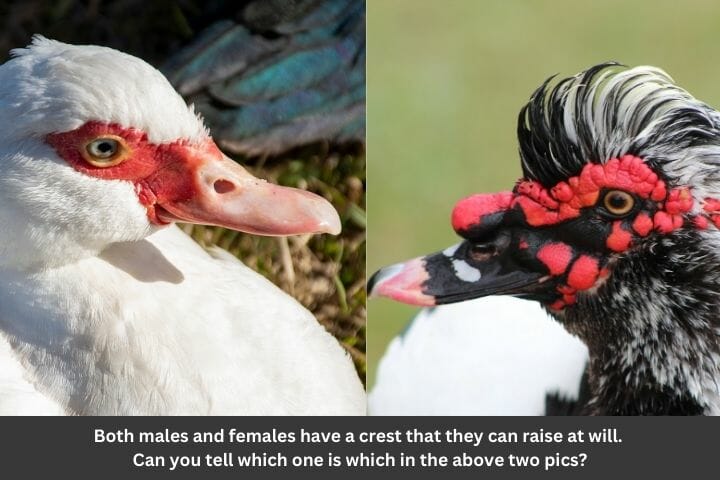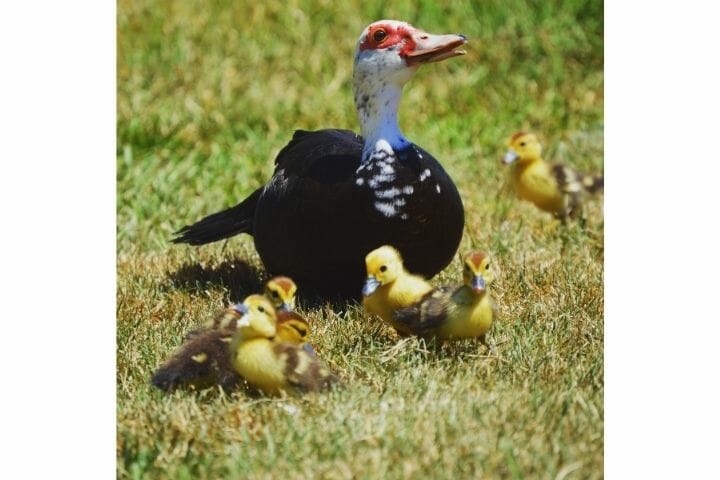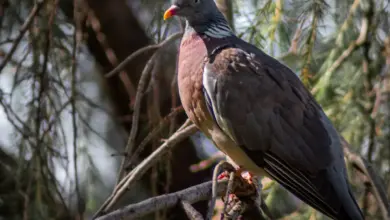Muscovy Duck Male Vs Female: Physical Differences and Sexing
In this article, we look at how to tell apart your Muscovy Duck male vs. female.
Muscovy ducks are a species of waterfowl native to Central and South America.
Readily domesticated populations of Muscovies can now be found worldwide.
At first glance, it may seem hard to differentiate between male and female Muscovy ducks.
However, there are noticeable differences. This guide will allow you to identify the differences between the two sexes confidently.

Male Muscovy Ducks
Muscovy ducks display sexual dimorphism. This means males and females look considerably different.
Male Muscovy ducks, also known as drakes, are relatively easy to identify based on their physical characteristics.
Males are considerably larger than female Muscovies, also referred to as hens. In fact, males are almost double the size of females.
The caruncle, or the red warty-like facial skin, is also more pronounced in males.
Female Muscovy Ducks
As mentioned above, females are a lot, dare I say, prettier than males! Their caruncles are less pronounced and usually not as rough.
They typically grow to be about 6.6 pounds and about 25 inches in length.
The females are a lot quieter than the chatterbug males, but they can also be the more aggressive of the lot, especially during the breeding season.
Speaking of breeding, mating season for muscovy ducks starts in August and covers almost the entire year up to May.
After mating, the females lay eggs. Depending on the weather, the mother duck can have as many as three to four broods, totaling between 60-120 eggs.
Each clutch will be about 15-20 eggs.
To lay her eggs, the mother duck will create a bird nest for herself in natural cavities in trees.
If you are raising a domestic duck, you can also provide her with a nest box to lay her eggs.
It takes about 35-37 days for egg incubation in muscovies. When the offspring hatch, they stay close to their mothers for about twelve weeks for safety and warmth.
At 12 weeks, the chicks are young adults, though not yet sexually mature. They start to wander on their own from there out.
Muscovies reach sexual maturity by the 29th week (males) and the 28th week (females).
How To Sex Muscovy Ducks
As we’ve just explored, males have distinct morphological traits that distinguish them from females.
However, this is assuming the male is a fully matured adult.
Although not conclusive, there are some specific signs you can look out for that will allow you to gauge an idea of what sex your Muscovy duck may be.
Let’s look at some of the traits:
Size
A Spanish study in 2011 used discriminant analysis of sexual dimorphism to find significant differences in the size of male and female Muscovies.
While examining a range of body parameters, it was observed that male Muscovy ducks had a significantly higher body weight, body length, breast and thigh circumference, bill, neck and wing length, and total leg length.

On average, an adult male Muscovy can weigh up to 10-15 lbs (4.5 6.8 kg) and reach lengths of, on average, 31 inches or 79 cm.
Females, on the other hand, weigh between 5-7 pounds (2.3 – 3.1 kg) and measure about 23.6 inches, or 60 cm.
Caruncle
Caruncle or the red tissue on muscovies’ faces is a feature unique to this breed of ducks. It almost looks like a red mask on their faces.
After their size, the caruncle is one of the easiest ways to differentiate between a male and female Muscovy.
At approximately 15 – 17 weeks of age, a male will start to develop a red, bumpy mass around the eyes.
A female, however, will not start developing her caruncle until roughly 20 weeks of age.
Even with the development of a caruncle in both males and females, it is possible to distinguish between the sexes.
The caruncle of a male is considerably larger, stretching from the eyes and bill tip to the neck and even to the back of the head in some cases.
The female caruncle tends to remain condensed around the eye region of the face.

Feathers
The use of feathers for sex identification purposes is relatively reliable.
It is also a great way to be able to determine the sex of your ducklings from an early age.
Despite males being bigger and growing faster, it is the females that tend to develop feathers first.
At around four weeks of age, a female will start to develop feathers around her wing and tail tips.
The feathers themselves are not drastically different between the sexes, but it is the speed at which a female Muscovy duck develops her feathers that set the sexes apart.
Tail
Sex determination via the tail comes after your Muscovy duck has developed their tail feathers.
Unfortunately, Muscovies only become fully feathered at around 12 weeks of age.
By this time, you should already be able to tell the sex of your Muscovy due to the size, prominence of the caruncle, and quantity of feathers.
But, if you want to be extra certain of the sex, the shape of the tail feathers is a giveaway.
Males will typically have a U-shaped formation of tail feathers, whereas the tail feathers of a female form a narrow, V-shaped alignment.
Of course, both male and female Muscovy ducks can move their feathers. This is most noticeable when a female is broody or agitated.
Males, and sometimes females, wag their tails as a form of communication. Oftentimes, it is to attract the attention of the opposite sex.
Bill
Bill color alone is not a valid way of sexing Muscovy ducks.
However, there are some physical characteristics you can use to determine whether your Muscovy is male or female.
Firstly, mature males will often have a large lump at the base of their bill. This is perfectly natural and nothing to worry about, even if it does look a bit odd to you or me.

Secondly, the bill of the male is, besides the basal bump, relatively straight and smooth. In comparison, the bill of a female is adorned with a central ridge and slightly more curved.
Despite the slight differences, this characteristic should be used more as a guide and not a definitive sex determination.
Behavior
Male and female Muscovy ducks behave differently.
Even if this is your first time raising Muscovies, you will begin to observe slight behavior changes between the two sexes.
Going back to the earlier Spanish study, it details that drakes have a wider stance, probably as a result of a larger thigh circumference and legs to support their weight.
Males are also typically more aggressive and territorial, especially if you have multiple males in the same flock.
You may see your Muscovies trying to dominate one another.
Dominance is a common trait in Muscovies and should not be a cause for concern. In fact, one of the adaptations of the caruncle is to protect soft areas of the duck’s skin.
If in doubt about how aggressive your duck is, contact a specialist.
However, aggression isn’t always the case. Young males often appear lazier, napping more and generally moving less than females.
Vocalization
If all else fails, and you are still trying to figure out if it is a drake or a hen, simply stop and listen.
After a certain age, males will only be able to produce one main sound. This will be a raspy-sounding hiss.
It is quite a fast-paced and unique sound, and it may also sound like it is struggling to breathe.
Do not panic. Again, this is natural and a key distinguishing factor between males and females.
Female Muscovies are capable of producing a more extensive vocal range, from clicks to shrill-like vocalizations.
Despite their vocal capabilities, however, females are often peaceful and quiet in nature.
The graceful female sits quietly, as the male chatters on with its hissing sound
Coloration
Unlike other duck species, such as those domesticated from a mallard ancestor, Muscovy ducks cannot be differentiated by their plumage coloration.
Both male and female Muscovies can display a range of colors, from white to black to green.
Wild Muscovy ducks are often black all over, with an iridescent glossy green shine. White patches can be found under the wings.
Domesticated Muscovies typically have a larger proportion of white coloration, but this varies greatly for each individual.
Do Female Muscovy Ducks Have A Crest?
Mature males develop a stylish, Elvis-like crest on top of their heads.
This crest is primarily used to attract a mate. The bigger the crest, the better the chance a male Muscovy finds a mate.
So, that must mean a female doesn’t need a crest. Right?
Wrong.
Females have mini mohawks. The females have small crest feathers on the top of their heads.
The function of these feathers in females remains unknown, but it has been speculated they use them to communicate with conspecifics.

But What About Ducklings?
Now to throw a curveball.
You’ve successfully hatched or recently purchased Muscovy ducklings. Great!
If you think you’re a bad parent for not being able to differentiate between your ducklings, do not worry. You are not alone.
As with chicks, sexing ducklings is a near-impossible task. After all, each duckling is a ball of pure fluffy cuteness.
You could vent sex to your ducklings, which is the manual examination of the duckling’s reproductive organs, but this is something only trained personnel can carry out.
If done incorrectly, you risk injuring your Muscovy duckling. If you are desperate to know the sex on day one, you can take the duckling to a veterinary specialist.
In most cases, you will have to wait until about four weeks of age to find out the sex of your mini Muscovies.


What Muscovy Sex Is Best For Meat?
Across the globe, Muscovy ducks have been domesticated as meat-type ducks.
But is there a difference when it comes to the sex of the species?
As it turns out, yes. Sex plays an important role in the taste and quality of Muscovy duck meat.
Due to their bigger size, males have more pronounced breasts. Females have smaller, more streamlined breasts.
A scientific study looking at the composition of breast muscle in male and female Muscovies suggests that, at any given age, the breast meat of female ducks appeared less tender, less juicy, and more stringy, when compared to the males.
However, the taste itself has a deeper, more rich, and more intense flavor compared to that of the males.

Frequently Asked Questions
Can Muscovy ducks change gender?
Do Muscovy ducks bond with humans?
Do Muscovy ducks mate for life?
Do male Muscovy ducks quack?
Conclusion
Male and female Muscovy ducks display sexual dimorphism. Males are typically larger than females.
You can also distinguish the two sexes by looking at their bill, feathers, and behavior. This is normally once the duckling is at least four weeks of age.
You will not be able to tell the sex of your Muscovy by the color of its plumage.
I hope you have found this guide useful. Happy Muscovy sexing!
References
Mississippi State University, Poultry, Sexing day-old chicks, Updated Dec 2022
University of Cordoba, Spain, A. Yakubu, 2011
British Poultry Science, E. Baeza, et al, June 2010




